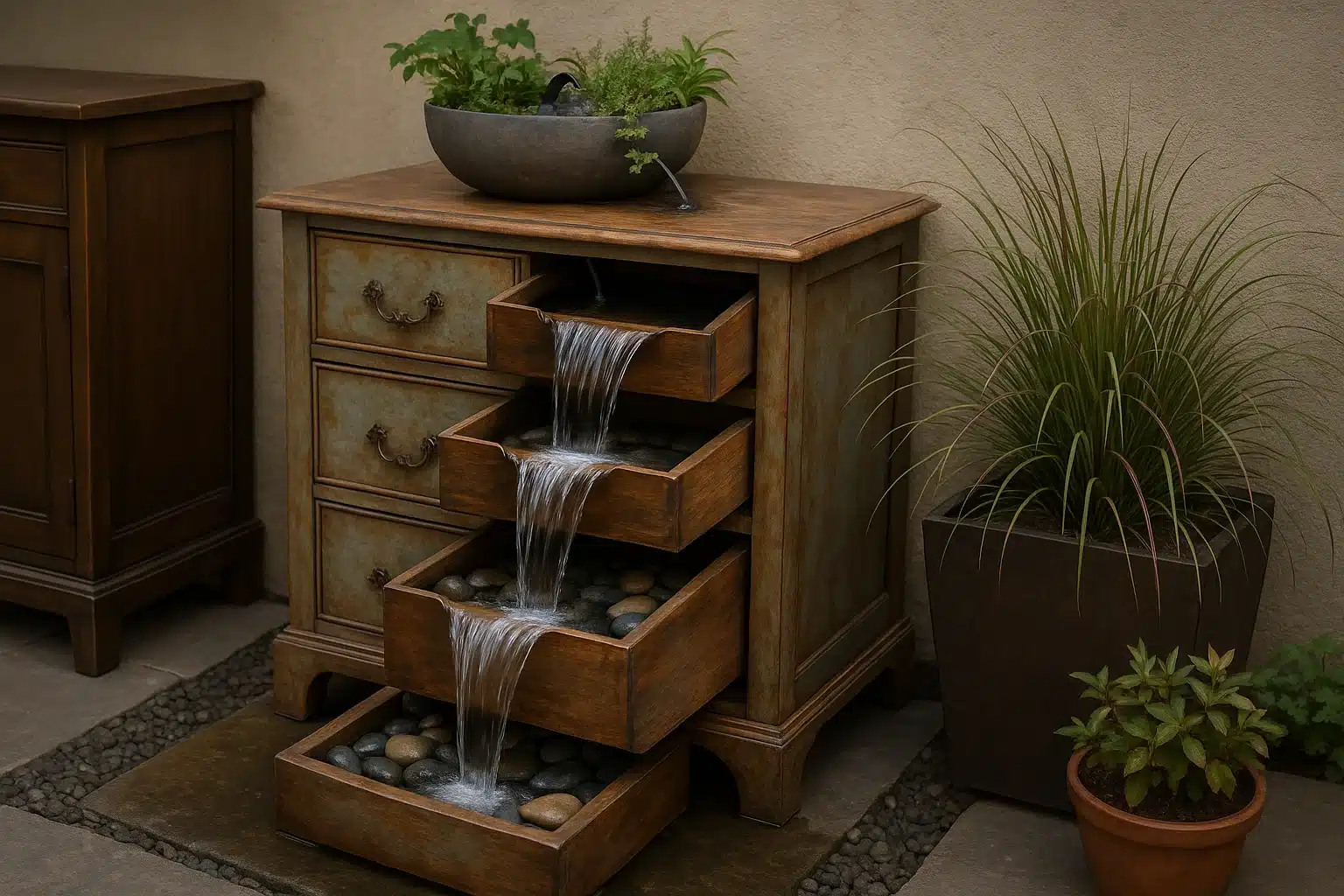Introduction
Imagine walking into a backyard or living space where a once-forgotten dresser now ripples with flowing water, or a vintage cabinet bubbles gently as a unique indoor fountain. Repurposing old furniture into water features is more than just an upcycling trend, it’s a statement of creativity, sustainability, and style. Whether you’re a DIY enthusiast, a designer seeking bold centerpiece ideas, or simply someone who loves merging form with function, this approach offers endless possibilities.
In this comprehensive guide, we’ll explore how to turn furniture into water features, from dressers and cabinets to side tables, chests, and more. You’ll learn design considerations, material compatibility, waterproofing methods, pump installation tips, and see inspiring project ideas. By the end, you’ll have the confidence and knowledge to start your own functional art piece.
Why Repurpose Furniture into Water Features?
- Sustainability & Waste Reduction: Instead of sending old furniture to the landfill, you can give it a second life as a functional focal point.
- Customization & Personalization: Each piece is unique—reflecting your taste, space, and creativity.
- Cost Efficiency: Using an existing furniture piece often costs less than buying a brand-new fountain.
- Conversation Starter: Guests are instantly intrigued by unconventional designs like a dresser-turned-waterfall.
Choosing the Right Furniture
- Material: Solid wood, metal, or sturdy MDF (with waterproofing) work well. Avoid thin particleboard, which swells easily when wet.
- Structure: Furniture should be stable and able to support the weight of water, pumps, and decorative elements.
- Shape & Size: Consider where you’ll place the feature—indoors, outdoors, or in a transitional space.
Examples of Furniture to Repurpose:
- Vintage dressers
- Kitchen cabinets
- Sideboards or buffets
- Bedside tables
- TV stands
- China hutches
Planning Your Water Feature
1. Determine the Type of Water Flow
- Sheet Waterfalls: Water flows over a flat surface or spout.
- Tiered Flow: Water cascades from one section to another, like dresser drawers.
- Bubbling Feature: Water emerges from a small spout or decorative nozzle.
2. Measure Water Volume & Weight
Water weighs approximately 8.34 pounds per gallon, so ensure your furniture can handle the load, including decorative stones or plants.
3. Select Pump & Filtration
Choose a submersible pump sized to your feature’s height and flow requirements. Indoor features may need quieter pumps, while outdoor ones can handle more power.
Step-by-Step: Turning a Dresser into a Water Feature
Example Project: A Cascading Drawer Fountain
- Prepare the Dresser: Remove unnecessary drawers or modify them for water flow. Sand and clean surfaces.
- Waterproof the Interior: Apply pond liner, marine-grade epoxy, or liquid rubber sealant to any area that will hold water. Pay special attention to drawer seams.
- Install the Pump: Place it in the lowest drawer or basin. Run tubing up the back to the highest water outlet point.
- Create the Water Path: Tilt drawers slightly so water flows forward. Use waterproof caulking to direct water.
- Test the Flow: Fill with water and run the pump. Adjust tubing or drawer angles until water cascades smoothly.
- Add Decorative Elements: Stones, plants, LED lighting, or ceramic accents can enhance the look.
Cabinet-to-Fountain Transformations
- Enclose Pumps and Electricals: Cabinets can hide unsightly mechanics.
- Integrated Lighting: Add LED strips inside shelves or niches for a dramatic evening effect.
- Glass Panels: Replace cabinet doors with tempered glass for a modern, aquarium-like effect.
Inspiration Idea: Convert a tall vintage armoire into a rain curtain feature with a hidden reservoir at the base.
Waterproofing Techniques
- Pond Liners: Flexible, durable, ideal for irregular shapes.
- Marine Epoxy: Creates a hard, water-resistant surface; perfect for wood.
- Liquid Rubber Coatings: Easy to apply and repair over time.
- Fiberglass Sheets: Great for heavy-duty projects but require skill to install.
Pro Tip: Seal both inside and outside surfaces to prevent moisture damage from splashes.
Design Styles to Explore
Rustic Charm
Use distressed wood, antique handles, and natural stones. Perfect for cottage gardens or farmhouse interiors.
Modern Minimalism
Choose sleek cabinets, clean lines, monochrome finishes, and hidden lighting.
Eclectic Art Piece
Mix colors, patterns, and unconventional decor—like ceramic figurines or glass mosaics.
Zen & Nature-Inspired
Integrate bamboo, pebbles, and soft lighting for a calming indoor feature.
Indoor vs. Outdoor Considerations
Indoor
- Quieter pumps
- Splash guards to protect flooring
- Minimal evaporation
- Potential humidity control
Outdoor
- Weatherproof materials
- UV-resistant finishes
- Stronger pumps for higher flow rates
- Seasonal maintenance (draining before freezing weather)
Creative Project Ideas
- Drawer Garden Fountain: Combine cascading water with potted plants in open drawers.
- Cabinet Rain Wall: Install a rain panel inside a repurposed display cabinet.
- Nightstand Bubble Feature: Perfect for a bedroom or office, compact and soothing.
- Kitchen Island Stream: Convert an old kitchen island into a centerpiece with a built-in stream.
Maintenance & Longevity
- Weekly: Check water levels, clean pump intake.
- Monthly: Remove algae, wipe surfaces, inspect seals.
- Seasonally: Drain and store if outdoors in freezing climates.
Tip: Use distilled water indoors to reduce mineral deposits.
Benefits of Furniture-Based Water Features
- Unique, one-of-a-kind aesthetics
- Customizable to match decor
- Eco-friendly upcycling
- Versatility in size and function
- Personal satisfaction from DIY craftsmanship
Final Thoughts
Repurposing furniture into water features is an art form that blends creativity, engineering, and sustainability. Whether it’s a cascading dresser, a bubbling cabinet, or a minimalist side table fountain, these pieces transform spaces and spark conversations. With careful planning, proper waterproofing, and thoughtful design, your furniture-turned-fountain can bring beauty and serenity for years to come.







